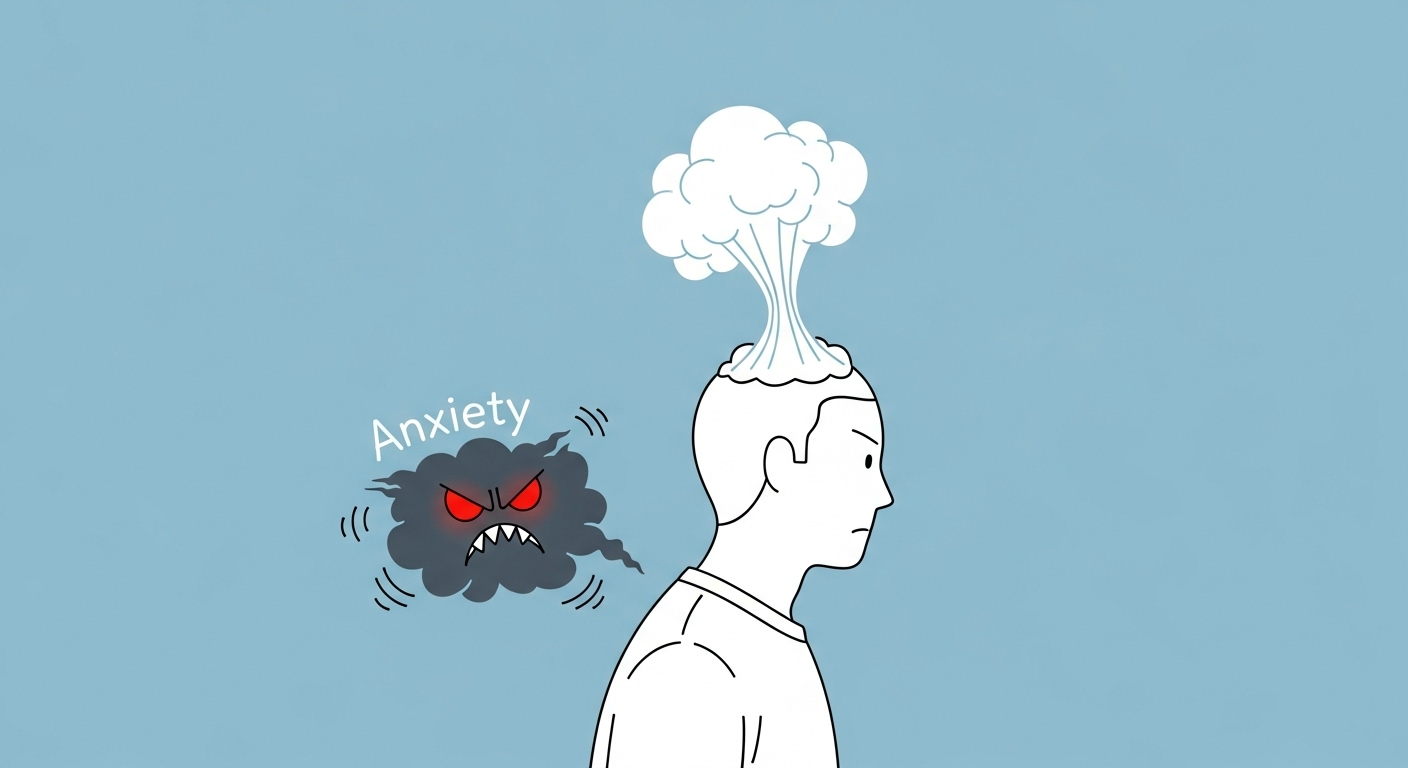Introduction: When Anxiety Feels Like Anger
Anxiety feels like anger for many people, and it can be confusing. The emotions often overlap, creating tension, irritability, and frustration. Writers, professionals, students, and parents alike experience this emotional blend. Recognizing the link between anxiety and anger is the first step toward managing it.
When left unchecked, this overlap can affect relationships, work performance, and mental well-being. Understanding why anxiety sometimes triggers anger empowers you to respond rather than react. This article explores the causes, triggers, and coping strategies to help you navigate emotional overwhelm with calm and clarity.
The Science Behind Anxiety and Anger
Anxiety and anger share similar pathways in the brain. Both involve the amygdala, the brain’s emotional center responsible for processing fear and threat. When the brain perceives danger, it activates the fight-or-flight response, preparing the body to respond quickly.
Anxiety triggers vigilance and hyperawareness. Anger often emerges as a defensive reaction. The result is emotional intensity that can feel overwhelming.
The Fight-or-Flight Response
When the body senses a threat, it releases adrenaline and cortisol. These stress hormones increase heart rate, blood pressure, and alertness. Anxiety prepares the body to respond to perceived danger. Anger, in turn, can surface as a protective or aggressive response. Together, these responses amplify emotional tension.
Brain Chemistry and Emotional Overlap
Neurotransmitters like serotonin and dopamine play a crucial role in mood regulation. Low serotonin can make anxiety harder to control, increasing irritability and impulsivity. Fluctuations in dopamine affect motivation and emotional responses. This chemical interplay can cause anxious thoughts to feel aggressive or angry.
Physical Symptoms That Connect Anxiety and Anger
Physical sensations often blur the line between anxiety and anger. Common signs include:
- Rapid heartbeat
- Muscle tension
- Shallow or rapid breathing
- Restlessness
- Sweating or nausea
Recognizing these cues helps you intervene before anger escalates.
Real-Life Examples When Anxiety Feels Like Anger
Many people experience this emotional crossover in daily life.
- Writers often feel anxious about deadlines. Anxiety can quickly turn into irritability or anger at themselves or their surroundings.
- Students may feel anxious before exams. Frustration and anger can emerge when they perceive themselves as unprepared.
- Professionals facing high-pressure meetings often notice impatience or irritability, which may be anxiety disguised as anger.
Understanding that these emotions are connected allows for compassion toward oneself. Emotional awareness prevents unnecessary conflict and self-blame.
Common Triggers When Anxiety Feels Like Anger
when Anxiety Feels Like Anger, Stressful Situations and Environmental Pressure
High-pressure environments, constant demands, and conflict increase the likelihood that anxiety will manifest as anger. Deadlines, work overload, or challenging social interactions can trigger this crossover.
when Anxiety Feels Like Anger, Internal Thoughts and Rumination
Overthinking is a common driver of anxiety. Negative self-talk or imagining worst-case scenarios increases tension. This mental pressure can suddenly explode as anger, often directed at oneself or others. Recognizing these thought patterns is crucial for managing emotional responses.
H3: when Anxiety Feels Like Anger, Sensory Overload
Loud noises, crowded spaces, and constant notifications can heighten anxiety. Overstimulation can make it difficult to regulate emotions, causing irritability or anger to surface.
Practical Strategies to Manage when Anxiety Feels Like Anger
Coping with anxiety-driven anger is possible with simple, intentional practices.
Mindfulness and Breathing Techniques
- Practice deep, slow breathing to reduce tension.
- Focus on your inhale and exhale to stay present.
- Observe emotions without judgment to identify the source.
- Short daily meditation sessions calm both anxiety and anger.
Even two to three minutes of focused breathing can prevent emotional escalation.
Journaling and Emotional Awareness
- Write down feelings as they occur to gain perspective.
- Identify patterns where anxiety triggers anger.
- Use prompts like: “What am I feeling right now?” and “Why am I reacting this way?”
- Reflecting on triggers prevents impulsive reactions.
Journaling transforms emotional energy into insight rather than conflict.
Physical Movement and Energy Release
- Engage in light exercise like walking, stretching, or yoga.
- Tai chi or mindful movement reduces muscle tension and adrenaline buildup.
- Physical activity improves mood, reduces irritability, and promotes emotional regulation.
Even a short five-minute break to stretch or move can reset your emotional state.
Creative Expression
- Drawing, painting, or music allows safe expression of emotions.
- Writing poetry or short stories channels anxious energy creatively.
- Hobbies act as emotional buffers, preventing anxiety from turning into anger.
Long-Term Approaches for Emotional Balance
Therapy and Professional Support
- Cognitive Behavioral Therapy (CBT): Helps reframe anxious thoughts and reduce emotional triggers.
- Talk therapy: Provides a safe space to explore anger patterns.
- Mindfulness-Based Stress Reduction (MBSR): Strengthens emotional regulation over time.
Professional support is invaluable when emotions feel overwhelming or persistent.
Lifestyle Adjustments and Routine
- Maintain regular sleep patterns to stabilize mood.
- Reduce caffeine and alcohol, which can exacerbate anxiety.
- Engage in relaxing hobbies for emotional release.
- Establish daily routines for structure and predictability.
Long-term changes make coping automatic and reduce emotional spikes.
Social Support
- Talk with trusted friends or family about feelings.
- Joining support groups can normalize experiences and provide new coping tools.
- Healthy social connections buffer against stress and prevent emotional escalation.
Additional Daily Coping Tips
- Recognize early signs of tension before anger escalates.
- Pause before reacting; even a few deep breaths helps.
- Use “I feel” statements to communicate calmly.
- Schedule short breaks to prevent emotional overload.
- Keep a stress toolkit: journal, music, breathing exercises, or mindfulness apps.
These small, consistent habits reduce the frequency and intensity of anxiety-driven anger.
read more : Focus Bamboo Flute : A mindful Productivity hack for writers
Benefits of Understanding Anxiety-Anger Overlap
- Emotional Clarity: Separating feelings from reactions improves self-awareness.
- Better Relationships: Awareness reduces unintentional outbursts and conflicts.
- Improved Productivity: Managing emotional spikes maintains focus and efficiency.
- Personal Growth: Learning coping strategies builds resilience and self-trust.
- Reduced Stress: Recognizing triggers helps prevent burnout and mental fatigue.
FAQ: Common Questions About Anxiety and Anger
Q1: Why does anxiety sometimes feel like anger?
Anxiety triggers the fight-or-flight response. The same physiological reactions that increase alertness also prepare the body for defensive behavior, which can appear as anger.
Q2: Can mindfulness really help?
Yes. Mindfulness teaches awareness of emotions without judgment. It interrupts the automatic escalation from anxiety to anger.
Q3: How long does it take to manage these emotions?
Short-term relief is possible with breathing and movement. Long-term management requires consistent practice, therapy, or lifestyle adjustments.
Q4: Is it normal to feel both emotions simultaneously?
Absolutely. Anxiety and anger often overlap, especially under stress. Awareness and coping strategies are key to handling them effectively.
Q5: Can exercise really reduce anger triggered by anxiety?
Yes. Physical activity reduces stress hormones, releases tension, and improves mood, preventing escalation of anger.
Conclusion: Transform Anxiety Into Calm Awareness
When anxiety feels like anger, it can be overwhelming and confusing. Recognizing the link between these emotions is the first step toward change. Using mindfulness, journaling, movement, creative expression, and professional support transforms emotional overwhelm into calm awareness.
Coping daily with small, intentional strategies prevents escalation and creates long-term emotional balance. Over time, these practices reduce stress, improve relationships, and enhance overall well-being.
Call to Action:
Start observing your emotions today. Notice when anxiety edges into anger. Practice mindfulness, breathe deeply, and regain control over your emotional responses. Heal | Mental health Hub , Recovering me







Leave a Reply